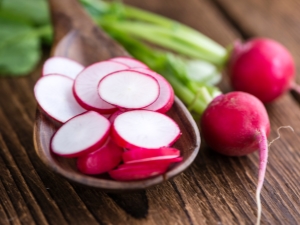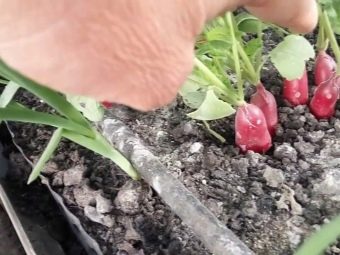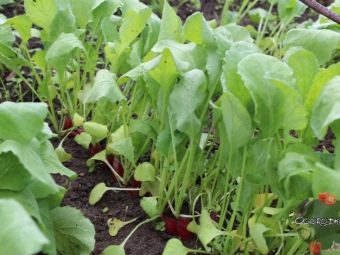Why is radish bitter and what to do?

Radish is a vegetable plant that belongs to the cruciferous family.The root crop has a rounded or elongated shape, the color of the vegetable can be very diverse: red, purple, yellow, white, pink. The most popular varieties of red and red and white colors. This plant is rich in vitamins and trace elements necessary for human life.
Radish is a common plant with unique antibiotic properties. It destroys the microbes that form in the mouth and pharynx and cause unpleasant odors. While chewing fresh root vegetables under the influence of the substances that make up the radish, microbes die, besides mustard oils irritate taste buds, improving appetite. In addition, it is proved that the use of fresh radish reduces the risk of the formation of tumors and the occurrence of cancer.
Radish is unpretentious to the conditions of cultivation, but in the presence of excellent fertile soil basic requirements must be observed. Otherwise, the vegetable will be bitter and flabby.
The reasons
The main reason for the bitter, sometimes bitter taste of radish is the presence of mustard oil in the fruit. It gives the vegetable beneficial properties and piquancy in the taste of the pulp. This culture belongs to the early spring vegetables, preferring not too long daylight hours. It should not exceed 10 hours. Most often, planting begins in early spring or late summer.
Possible planting in the greenhouse immediately after melting snow. At this time, the temperature and light conditions are more suitable for the germination of strong plants. From the excess of light during the day the plant ages faster and its fruits begin to taste bitter. To slow down this process, landings cover with opaque covering materials, forming a shady place. But too much blackout of plants will cause a radish in radish, so it needs to be regulated by opening-closing.
When covering landings, it is important to ensure that the oxygen supply to the plants is free.
In order to get rid of the bitter taste in the vegetable, you need to find out why it appeared. There may be several reasons for this:
- insufficient and uneven (from time to time) watering;
- overgrowing of root crops: when overripe the pulp becomes rough, cracks, dries from the inside, bitterness appears;
- unprepared planting radish, lack of oxygen, no weeding from weeds.
The bitter taste of radish appears because of non-compliance with the rules of cultivation of this vegetable. Violation of at least one of the conditions leads to a deterioration in the quality of the entire crop or its complete absence.
Conditions for obtaining a good harvest
To get a tasty, juicy vegetable culture with a pleasant sweet taste and unobtrusive ostrykoy, seedlings need regular and high-quality care.
Thinning
When thickened planting radish expect a good taste at the root should not be. When too cramped vegetables grow weak, depleted, lack nutrients and microelements. The root system of such seedlings does not develop. The lack of light rays and water affects the formation of the root. The plant is fighting for space and food, and does not direct forces to the development of the fetus.
Remove the extra and weak seedlings should be in the period when there was one real leaf. A later negative pressure will lead to the fact that a part of the plants passes into the stage of formation of an arrow with flowers. Thinning must be carried out on a mandatory basis, the distance between the plants should not be less than 4 cm, otherwise the pulp of radish will harden, acquire fibrous and dry. The vegetable will take on curved shapes.
The option of planting seeds using cells from egg grids. We press them into the soil and get a clear number of grooves for planting seeds. One seed is planted in each well. With this method of planting thinning is not required.
Thin out and then loosen the soil with radish should be very carefully, avoiding damage to the roots of plants. Otherwise, the culture will start to form arrows, the nutritional qualities of the vegetable will lose their value. It is worth thinning radishes not by pulling out excess plants, but by pinching.
Watering
Radish - moisture-loving plant. The requirement for the presence of moisture in the soil appears when the first true leaf appears, at the very beginning of the formation of the root part of the vegetable. He needs a timely, uniform, regular flow of moisture into the soil. Ideally, watering 1 square meter of garden beds with radish requires 10-15 liters of not very cold water. Do not allow the land to dry out around the crop. Fruits that have experienced a lack of moisture do not compensate for it after restoring the irrigation regime. The flesh loses its taste, crispness. This vegetable is prone to cracking, loss of smoothness, prone to bolting.
On hot summer days, radishes should be watered early in the morning and late in the evening every day. With the onset of cooler weather, watering can be reduced to 1 time in 2-3 days, observing the condition of the soil and preventing it from drying out. Day watering does not benefit, as water from plants quickly evaporates through the leaves. Shedding the soil layer should be carried out at a distance equal to the length of the radish root. If frequent watering is not possible, ridges with vegetables can be mulched using sawdust, dry grass. So moisture in the soil after watering is maintained for a long period.
Proper watering of radish should be carried out with a watering can with a frequent strainer, when grown in greenhouse conditions immediately after the end of watering the room must be aired. In the absence of regular watering, the cultivation of radish becomes absolutely useless.
Performing irrigation culture, too keen on not too worth it. Like a deficiency, an excess of water in the ground can cause the bitter taste of the vegetable. In addition, excessive soil moisture can cause the formation of various diseases of the root, its rotting
Weeding
Weeding of beds from the appeared weeds is carried out regularly. Weeds pick up moisture and trace elements from cultivated plants, block access to light rays. Radish grows weaker, depleted compared to a vegetable from weeded beds. Weeding rows with radish should be done very carefully, removing the weeds with light movements, trying not to damage the seedlings of the crop itself.
Loosening
Inter-row spaces should be loosened immediately after watering or rain. Drying, the soil forms on the surface of a dense layer, not allowing oxygen in sufficient quantities. The plant lacks it and weakens. The fruit is poured with bitterness.
Loosening is done dotted around each radish bush.
Timely Harvesting
Radish fruits are harvested as they ripen. During the warm period, the culture must form a root crop with a diameter of up to 2 cm in order to become suitable for storage. In terms of ripening, this process lasts from 20 to 45 days depending on the variety of the crop. It is useless to leave large vegetables in the soil, their growth will stop, the flesh will be roughened, dried and the formation of fibers. Keep the radish in a cool room, tied in bunches. At elevated storage temperature, the vegetable becomes soft, flabby.
Some vegetable growers practice this way: pour a thin layer of salt into each well before planting the seeds of the crop. It destroys germs and viruses in the soil and gives the root crops unusual tastes, the fruits become crispy, juicy. This method perfectly protects the roots from the formation of bitterness, as the salt absorbs and retains moisture.
How to eliminate bitterness?
If it was not possible to get rid of the causes of bitterness in time, the fruits suitable for cooking, You can "save" in several ways:
- Soak in salted cold water. We pre-clean the radish and foliage of radishes into a container and add about 2 liters of pure water with 1 tablespoon of salt in it. For half an hour, leave the roots to get wet, then drain the water and rinse with running water. If necessary, you can do so twice. But most often, in order to correct the bitterness, one soaking is enough.
- Rinsing. Rinse the peeled and chopped root crops under running water, salt. Salt pulls out excess bitterness. Then the salt from the surface of the slices can be shaken off or, if necessary, washed again with water.
- Boiling water. Peel the vegetables, cut them into pieces, fold them into a container and pour boiling water for about 8-10 minutes. The bitter taste will disappear, but some vitamins and microelements will also be destroyed. Scalloped radish is less suitable for salads.
- Lemon and sugar. Cut or grate radishes on a coarse grater, pour with freshly squeezed lemon juice, sprinkle with sugar on top. If you do not want to use sugar, natural honey will suit you, which will make the salad spicy.
- Salinization. Cut the radish into thin plates and sprinkle with salt. We are waiting for the radish to give juice. Then you need to wash the chopped vegetables in running water and sprinkle with lemon juice.
If it is necessary to urgently get rid of bitterness without soaking the salad using radish, you can fill it with oil and apply sour cream. She will hide the bitter taste of this vegetable.
Do not immediately get rid of bitterness. Her presence is very useful, and you can always remove it. When soaking, the mustard oils are partially washed out, the healing disinfecting properties decrease, therefore, the benefits of the vegetable also decrease.
The most delicious and tender radish will grow in sunny beds with light loosened soil. The yield of the vegetable depends on the availability of feeding, but it is worth remembering that radishes do not grow on soils with the addition of fresh manure. In this case, the plant will form only green foliage. In the beds with clay soils and low nutrient content, the roots will be flabby with obvious signs of bitter taste.
With the implementation of these simple rules for growing radish, anyone, even a novice gardener, will be able to get an excellent harvest of tasty, crunchy, juicy radish without any signs of obtrusive bitterness in taste.
How to grow radishes so that it is not bitter, see below.





































